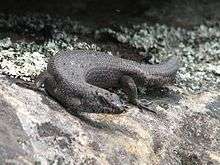Black rock skink
The black rock skink or black crevice-skink (Egernia saxatilis) is a species of moderately large to large skink, a lizard in the family Scincidae. It can reach a snout to base of tail length of up to 135 mm.[2]
| Black rock skink | |
|---|---|
 | |
| Scientific classification | |
| Kingdom: | Animalia |
| Phylum: | Chordata |
| Class: | Reptilia |
| Order: | Squamata |
| Family: | Scincidae |
| Genus: | Egernia |
| Species: | E. saxatilis |
| Binomial name | |
| Egernia saxatilis Cogger, 1960 | |
Distribution
The species is native to the south east of Australia, mainly on the coast and nearby ranges.[3] There are two subspecies, Egernia saxatilis saxatilis, which inhabits the Warrumbungle mountains of New South Wales, and Egernia saxatilis intermedia which inhabits the rest of the species' range.[4]
Ecology
Egernia saxatilis is active during the day, and eats small insects,[2], but in some seasons can also eat vegetation[5]. It lives in the crevices of rock outcrops, and stays near the crevice. It is particularly active during warm weather, and often interacts socially. They can be aggressive to other skinks that enter their area.[5].
The social organization of these Australian lizards is very complex, as a study has shown monogamous tendencies among this species, contrary to the polygamous tendency of reptiles in general.[6]. The adults and young can stay together for over a year, with the female annually producing 2 - 3 young. [2]. They are viviparous[4]. Based on examining similar species, it is thought that they can live for 10 years, and are mature by 2 - 3 years[5].
Conservation
The species is locally abundant, but distribution is severely fragmented and number of adults appears to be decreasing.[1] Egernia saxatilis was assessed by the NSW Threatened Species Committee, but there was not sufficient data to draw a clear conclusion on how threatened the species was, though due to the declining population further investigation was suggested. [5]
References
- Shea, G.; Cogger, H.; Greenlees, M. (2018). "Egernia saxatilis". IUCN Red List of Threatened Species. 2018: e.T109470565A109470572. doi:10.2305/IUCN.UK.2018-1.RLTS.T109470565A109470572.en.
- "Egernia saxatilis Cogger, 1960, Black Rock Skink". Musems Victoria Collections. Retrieved 11 April 2020.
- Wilson, Stephen K.; Swan, Gerry (2013). A Complete Guide to Reptiles of Australia. Chatswood, New South Wales: New Holland Publishers. p. 210.
- "Egernia saxatilis". The Reptile Database. Retrieved 20 February 2019.
- "Conservation Assessment of Egernia saxatilis saxatilis" (PDF). NSW Department of Planning, Industry and Environment. NSW Threatened Species Scientific Committee. Retrieved 11 April 2020.
- O'Connor, D.; Shine, R. (2003). "Lizards in 'nuclear families': a novel reptilian social system in Egernia saxatilis (Scincidae)". Molecular Ecology. 12 (3): 743–752. doi:10.1046/j.1365-294X.2003.01777.x. ISSN 1365-294X.
